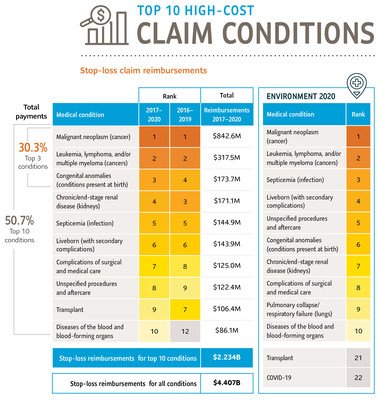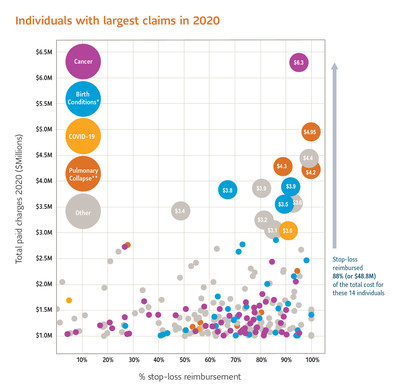Sun Life annual report on high-cost medical claims shows cancer continued to increase in cost and frequency despite pandemic environment
Sun Life's annual report reveals significant trends in high-cost medical claims from 2017-2020. Cancer remains the costliest condition, rising 16% in 2020, with notable increases in claims for mental health (21%), septicemia, and congenital anomalies. The average mental health claim was around $80,000. COVID-19 also played a role, with claims averaging $340,000 for severe cases. Sun Life plans to enhance member support through the acquisition of PinnacleCare, aiming to improve healthcare navigation for its clients.
- Acquisition of PinnacleCare to enhance member healthcare navigation.
- Increase in mental health claims indicates growing focus on mental health services.
- Cancer claims rose 16% in 2020, highlighting potential long-term healthcare challenges.
- Delayed screenings during the pandemic may result in advanced cancer diagnoses and increased mortality.
WELLESLEY, Mass., June 2, 2021 /PRNewswire/ -- Sun Life has released its annual research report on high-cost claims and medical trends. Cancer again topped the list of the 10 most common and costliest medical conditions, with an increase of 16 percent in 2020 despite the likely missed screenings during lockdown early in the pandemic. The report also showed that mental health claims increased by 21 percent in 2020 from 2019, with alcohol or opioid abuse and depression being the most common conditions. Septicemia (infections), one of the most common secondary conditions as a result of COVID-19, was also on the list of costliest conditions, as well as congenital anomalies (conditions present at birth, such as a heart defect) and kidney disease.
This year's report analyzed claims from 2017–2020 for more than 45,000 members. Sun Life will present a webinar on June 8 to provide insights on the report, with Jennifer Collier, R.N., senior vice president of Stop-Loss & Health; Mike Huppert, vice president of Actuarial & Risk Management; and Lisa Hundertmark, R.N., director of Clinical Services. Click here to register.
"We monitor these trends closely to make sure our employer clients and their employees get the care and support they need," said Collier. "Delayed screenings during the pandemic may result in some conditions, particularly cancer, being more advanced in their progression than they normally would have been at the time of diagnosis. It is crucial to support members with serious medical conditions and make sure they have access to the proper care and treatment, which is why we recently announced our intention to acquire PinnacleCare, a leading U.S. healthcare navigation provider that will help our members find the best physicians and centers of excellence for their specific condition."
Mental health spotlight
The pandemic likely contributed to the notable rise in claims related to mental health. In 2020, members with a stop-loss (high-cost) claim related to a mental health disorder rose 21 percent, and overall spend on mental health claims increased nearly 25 percent. The average cost in 2020 of a mental health claim per person was approximately
"Mental health is health," added Collier. "Often the symptoms and signs are harder to detect, even in the people we see or talk to every day. We encourage our clients to continue focusing on workplace mental health, which will foster positive impacts to their employees' overall health and well-being."
Other key takeaways from Sun Life's report include:
COVID-19 cost factors
- The highest COVID-19 claim was
$3 million . - Contributing factors that drove COVID-19 claims costs included long inpatient stays, duration of treatment, extensive diagnostics, cost of medication, complications, comorbidities and continued care.
- The relatively small number of COVID-19 cases that were severe enough to result in a stop-loss claim averaged approximately
$340,000 per patient, with infection and respiratory failure as the most common comorbidities contributing to high costs. - Other COVID-19 comorbidities that generated high costs in 2020 were acute renal failure, encephalopathy (brain damage), pneumonia, and cardiac dysrhythmia (abnormal heartbeat).
Cancer trends
- In 2020, members with a cancer claim increased by
16.1% ; members with prostate, colon, or breast rose by27% ,19% and12% respectively. - Experts predict there may be a significant increase in the coming years in cancer diagnoses and cancer-related deaths due to missed screenings and delayed diagnoses during 2020.
Specialty drug costs
- Nine out of the top 10 costliest injectable drugs are used to treat cancer, with average costs per patient ranging from about
$40,000 to$174,500 . - The two drugs with the highest average costs are Soliris and Ultomiris, used to treat blood disorders, with an annual average per person cost of about
$420,100 and$492,900 respectively. - Postponed clinical trials during the pandemic may result in delayed approvals and fewer new drugs in 2021.
Million-dollar claims
- Million-dollar+ claims increased
9% from 2019 to 2020. - The highest medical claim in 2020 was for cancer, totaling
$6.3 million . - The most frequent
$3 million -dollar+ conditions in 2020 included cancer, birth conditions, COVID-19 and pulmonary collapse. - There is no single driver of million-dollar claims; most are driven by some combination of complicated procedures, high-cost drugs, advanced life-sustaining treatments, and long in-patient hospitalizations, regardless of diagnosis.
Other pandemic impacts
- Costs for transplants actually decreased from an average of approximately
$303,000 per patient in 2019 to$140,000 in 2020, which could be a result of: - Less ongoing treatment and in-patient aftercare.
- Changes of treatment sites from larger hospitals to smaller community centers and home infusions.
"Medical trends that we see through our research reports prompted us to take a step back to consider how people utilize and interact with their healthcare, and how we can better serve our clients' evolving needs with new capabilities," said Dan Fishbein, M.D., president of Sun Life U.S. "Through concepts like care navigation, in-depth research, and investments in digital benefits solutions, we are doing more to help our clients and support our members."
Stop-loss insurance provides financial protection for employers who self-fund their medical plans, which provides more plan design flexibility and cost-containment options, but also means the employer takes on financial risk. According to Kaiser Health, 67 percent of U.S. workers are in a self-funded health plan. Sun Life is the largest independent stop-loss provider in the country, covering more than 4.5 million lives.
About Sun Life
Sun Life is a leading international financial services organization providing insurance, wealth and asset management solutions to individual and corporate Clients. Sun Life has operations in a number of markets worldwide, including Canada, the United States, the United Kingdom, Ireland, Hong Kong, the Philippines, Japan, Indonesia, India, China, Australia, Singapore, Vietnam, Malaysia and Bermuda. As of March 31, 2021, Sun Life had total assets under management of C
Sun Life Financial Inc. trades on the Toronto (TSX), New York (NYSE) and Philippine (PSE) stock exchanges under the ticker symbol SLF.
In the United States, Sun Life is one of the largest group benefits providers, serving more than 55,000 employers in small, medium and large workplaces across the country. Sun Life's broad portfolio of insurance products and services in the U.S. includes disability, absence management, life, dental, vision, voluntary, supplemental health and medical stop-loss. Sun Life and its affiliates in asset management businesses in the U.S. employ approximately 5,500 people. Group insurance policies are issued by Sun Life Assurance Company of Canada (Wellesley Hills, Mass.), except in New York, where policies are issued by Sun Life and Health Insurance Company (U.S.) (Lansing, Mich.). For more information, please visit www.sunlife.com/us.
Forward-looking information
Certain statements in this news release are forward-looking within the meaning of applicable securities laws and are subject to inherent risks, uncertainties and assumptions. Some of these assumptions and risks and uncertainties are described in Sun Life Financial Inc.'s (the "Company") news release announcing the acquisition of PinnacleCare under the heading "Forward-looking information", the Company's annual information form for the year ended December 31, 2020 under the heading "Risk Factors" and the Company's other filings with Canadian and U.S. securities regulators. The results or events predicted in these forward-looking statements may differ materially from actual results or events and we cannot guarantee that any forward-looking statement will materialize. Except as may be required by law, we do not undertake any obligation to update or revise any forward-looking statement made in this news release. See Section O – Forward-looking Statements of the Company's 2020 annual MD&A for additional information concerning forward-looking statements.
Media contacts:
Devon Fernald
Sun Life U.S.
781-800-3609
Devon.Portney.Fernald@sunlife.com
Connect with Sun Life U.S.
https://www.facebook.com/SLFUnitedStates
https://www.linkedin.com/company/sun-life-financial
https://twitter.com/SunLifeUS
![]() View original content to download multimedia:http://www.prnewswire.com/news-releases/sun-life-annual-report-on-high-cost-medical-claims-shows-cancer-continued-to-increase-in-cost-and-frequency-despite-pandemic-environment-301304083.html
View original content to download multimedia:http://www.prnewswire.com/news-releases/sun-life-annual-report-on-high-cost-medical-claims-shows-cancer-continued-to-increase-in-cost-and-frequency-despite-pandemic-environment-301304083.html
SOURCE Sun Life U.S.
FAQ
What did Sun Life's report on high-cost claims reveal about cancer trends?
How much did mental health claims increase according to Sun Life's report?
What was the average cost of COVID-19 related claims reported by Sun Life?
What is the significance of Sun Life's acquisition of PinnacleCare?










